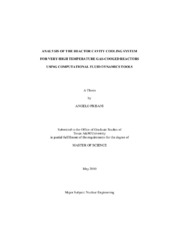| dc.contributor.advisor | Hassan, Yassin A. | |
| dc.creator | Frisani, Angelo | |
| dc.date.accessioned | 2011-08-08T22:47:43Z | |
| dc.date.accessioned | 2011-08-09T01:33:37Z | |
| dc.date.available | 2011-08-08T22:47:43Z | |
| dc.date.available | 2011-08-09T01:33:37Z | |
| dc.date.created | 2010-05 | |
| dc.date.issued | 2011-08-08 | |
| dc.date.submitted | May 2010 | |
| dc.identifier.uri | https://hdl.handle.net/1969.1/ETD-TAMU-2010-05-7767 | |
| dc.description.abstract | The design of passive heat removal systems is one of the main concerns for the modular Very High Temperature Gas-Cooled Reactors (VHTR) vessel cavity. The Reactor Cavity Cooling System (RCCS) is an important heat removal system in case of accidents. The design and validation of the RCCS is necessary to demonstrate that VHTRs can survive to the postulated accidents. The commercial Computational Fluid Dynamics (CFD) STAR-CCM+/ V3.06.006 code was used for three-dimensional system modeling and analysis of the RCCS.
Two models were developed to analyze heat exchange in the RCCS. Both models incorporate a 180 degree section resembling the VHTR RCCS bench table test facility performed at Texas A&M University. All the key features of the experimental facility were taken into account during the numerical simulations.
Two cooling fluids (i.e., water and air) were considered to test the capability of maintaining the RCCS concrete walls temperature below design limits.
Mesh convergence was achieved with an intensive parametric study of the two different cooling configurations and selected boundary conditions.
To test the effect of turbulence modeling on the RCCS heat exchange, predictions using several different turbulence models and near-wall treatments were evaluated and compared. The models considered included the first-moment closure one equation Spalart-Allmaras model, the first-moment closure two-equation k-e and k-w models and the second-moment closure Reynolds Stress Transport (RST) model. For the near wall treatments, the low y+ and the all y+ wall treatments were considered. The two-layer model was also used to investigate the effect of near-wall treatment.
The comparison of the experimental data with the simulations showed a satisfactory agreement for the temperature distribution inside the RCCS cavity medium and at the standpipes walls. The tested turbulence models demonstrated that the Realizable k-e model with two-layer all y+ wall treatment performs better than the other k-e models for such a complicated geometry and flow conditions. Results are in satisfactory agreement with the RST simulations and experimental data available.
A scaling analysis was developed to address the distortion introduced by the experimental facility and CFD model in simulating the physics inside the RCCS system with respect to the real plant configuration. The scaling analysis demonstrated that both the experimental facility and CFD model give a satisfactory reproduction of the main flow characteristics inside the RCCS cavity region, with convection and radiation heat exchange phenomena being properly scaled from the real plant to the model analyzed. | en |
| dc.format.mimetype | application/pdf | |
| dc.language.iso | en_US | |
| dc.subject | Turbulence | en |
| dc.subject | buoyancy | en |
| dc.subject | convection | en |
| dc.subject | RCCS | en |
| dc.subject | CFD | en |
| dc.subject | VHTR | en |
| dc.title | Analysis of the Reactor Cavity Cooling System for Very High Temperature Gas-cooled Reactors Using Computational Fluid Dynamics Tools | en |
| dc.type | Thesis | en |
| thesis.degree.department | Nuclear Engineering | en |
| thesis.degree.discipline | Nuclear Engineering | en |
| thesis.degree.grantor | Texas A&M University | en |
| thesis.degree.name | Master of Science | en |
| thesis.degree.level | Masters | en |
| dc.contributor.committeeMember | Chen, Hamn-Ching | |
| dc.contributor.committeeMember | Tsvetkov, Pavel V. | |
| dc.contributor.committeeMember | Ugaz, Victor M. | |
| dc.type.genre | thesis | en |
| dc.type.material | text | en |


